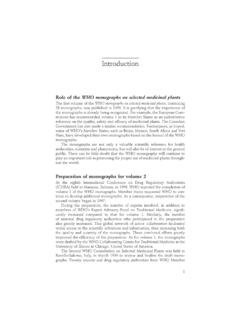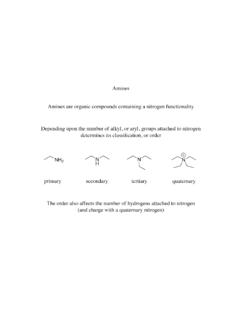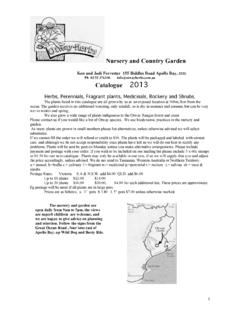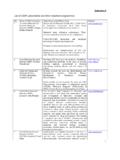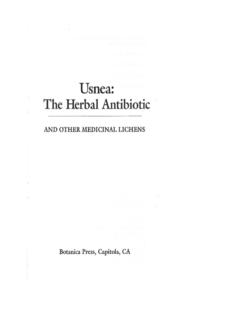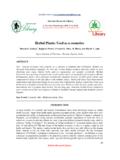Transcription of Guidelines for Good Agricultural and Wild …
1 Guidelines for good Agricultural and wild collection Practices for medicinal and aromatic plants (GACP MAP) The Guidelines for the good Agricultural and wild collection Practices for medicinal and aromatic (Culinary) plants are intended to apply to the cultivation, wild collection and primary processing practices of all such plants and their derivatives traded and used in the European Union. Hence they apply to the production of all plant materials utilized either in a direct or processed form for humans and/or animals. They also apply to all methods of production including organic production in accordance with the European regulations. EUROPAM, the European Herb Growers Association Brussels, November, 2010; EUROPAM GACP MAP Working Copy no. Document History: August 1998 First EUROPAM version December 1998 Discussion in EMEA ad hoc working group February 1999 Comments by EMEA ad hoc working group EMEA/HMPWG/17/99 draft and 18/99 draft June 1999 Updated to EUROPAM working copy March 2000 Release for consultation by EUROPAM June 2000 Deadline for comments November 2000 Release of EUROPAM working copy March 2001 Review meeting September 2001 Release of EUROPAM working copy ( ) February 2002 Review meeting EUROPAM working copy May 2002 Release EUROPAM working copy June 2003 Release for consultation EUROPAM working copy no.
2 6 September 2003 Deadline for comments November 2003 Release EUROPAM working copy July 2004 Release for consultation EUROPAM working copy no. November 2005 Release EUROPAM working copy April 2006 Release EUROPAM working copy November 2010 GACP MAP working copy Notes: *It is acknowledged by the members of EUROPAM that EHIA (The European Herbal Infusion Association) has contributed substantially to the establishment of the drafted GACP MAP Guidelines . GACP MAP, page 1 1. General Introduction .. 3 2. Personnel and Facilities .. 4 4. Cultivation .. 6 5. Harvest/ wild collection .. 7 6. Primary processing .. 8 7. Packaging .. 9 8. Storage and Transport .. 10 9. Equipment .. 11 10. Documentation .. 11 11. Quality Assurance .. 12 12. Self Inspection .. 13 GACP MAP, page 2 1. General Introduction Scope. The Guidelines for the good Agricultural and wild collection Practices of medicinal and aromatic (Culinary) plants (GACP MAP) are intended to apply to the cultivation, wild collection and primary processing practices of all such plants and their derivatives traded and used in the European Union.
3 Hence they apply to the production of all plant materials utilized either in a direct or processed form for humans and/or animals as pharmaceuticals, food and feed supplements and cosmetics. They also apply to all methods of production including organic production in accordance with the European regulations. The Environment. Cultivation In the course of the entire production process, in general, care should be taken to avoid environmental disturbances. The principles of good crop husbandry must be followed including an appropriate rotation of crops. Growers involved in the production of medicinal and aromatic plants must ensure that they avoid damage to existing wildlife habitats, and that they make efforts to maintain and to enhance the biodiversity of their farms. These efforts should include: a) Monitoring plant and animal species whose on farm presence is evidence of good environmental practice.
4 B) good Management the aquatic environment of the farm to encourage wildlife. c) Conserving and good management of landscape elements with ecological importance ( hedgerows, forest patches and buffer zones). wild collection All the involved parties in the harvesting of wild plants must ensure that they avoid damage to existing wildlife habitat. In particular the harvester must avoid: a) Extinction of particular species in certain zones or certain rare genetic populations due to over exploitation. Where possible, the principle of " collection rotation" to facilitate biological propagation and resource renewal should be employed. b) Destruction of the entire plant, due to carelessness and inexperience on behalf of the harvester, when in most cases it would be sufficient to harvest only a part of it. c) Confusion (due to ignorance or bad faith) in the harvesting of different species those are at first sight similar.
5 GACP MAP, page 3 d) collection of endangered species, according to local regulation. For plant intended for export from the country of collecting the Convention on International Trade in Endangered Species of wild Fauna and Flora (CITES) certificate must be obtained. Quality. The present good Agricultural and wild collection Practices Guidelines provide additional standards for the production and processing of raw materials focusing on the identification of those critical steps that are needed to comply with good quality. In this respect, they will be aimed at minimizing insufficient quality by prevention. The recommendations of this document are aimed at offering Guidelines for national regulations. Hygiene. A main aim is to ensure that the plant raw material meets the demands of the consumer and the standards of the highest quality. Especially important aspects are that they are: a) produced hygienically, in order to reduce microbiological load to a minimum, b) produced with care, so that the negative impacts affecting plants during cultivation, wild collection and processing and storage can be limited.
6 Since medicinal and aromatic plants and their derivatives are exposed, in the course of production process, to a large number of both microbiological and other contaminants, the main aim of present Guidelines is to provide guidance for producers and collectors in order to reduce plant (raw material) contamination to the greatest extent. Realisation. All participants of the production process (from primary producers to traders) are required to comply with these Guidelines voluntarily and to elaborate practical measures in order to realize them; moreover they, as far as it is concerned, should gather all the documentation (Confidential), in order to keep the traceability of the production process. The most important information about the batch should always follow the material by a Batch Documentation (Records and/or labels). Growers, collectors, traders and processors of medicinal and aromatic plants should be encouraged to respect and comply with the GACP.
7 MAP Guidelines , and demand that their partners also meet these requirements. 2. Personnel and Facilities Personnel should receive adequate education before performing tasks that require this knowledge and to know the best techniques for cultivation, harvesting, processing, drying and conservation, in order to guarantee the highest possible quality of the product. The collectors should have an appropriate botanical education, in order to identify the plants to harvest, without making any mistakes between the plant to crop and similar ones, in order to avoid undesired mixings. The degree of knowledge of the collectors must be periodically verified from a competent person put in charge by the collection organisation. GACP MAP, page 4 The development of the knowledge of the persons has to be documented in a written form. Personnel entrusted with the plant material should be required to have a high degree of personal hygiene (including personnel working in the fields) and have received adequate training regarding their hygiene responsibilities.
8 The buildings where the plant processing is carried out have to be provided with changing facilities as well as toilets including hand washing facilities, according to the respective regulations. Persons suffering from known infectious diseases transmittable via food, including diarrhoea, or being transmitters of such diseases, must be suspended from areas where they are in contact with the plant material, according to the respective regulations. Persons with open wounds, inflammations and skin infections should be suspended from the areas where the plant processing takes place, or have to wear appropriate protecting clothing or gloves, until their complete recuperation. Personnel should be protected from contact with toxic or potentially allergenic plant materials by means of adequate protective clothing. The welfare of all staff involved in the growing and processing shall be ensured. Health regulations should be displayed in the working area.
9 All processing procedures must completely conform to both EU Guidelines on Food Hygiene and the General Principles for Food Hygiene of the Codex Alimentarius as well as the European Directive on good Manufacturing Practice. GACP MAP, page 5 3. Seeds and propagation material Seeding materials are to be identified botanically, indicating plant variety, cultivar, chemotype and origin. The material used should be traceable (see Documentation). The same applies to vegetatively propagated starting material. Starting materials used in organic production have to be certified as organic'. Starting material should meet the requirements/standards concerning purity and germination (wherever available: certified seed/propagation material should be used). The starting material should be as free as possible of pests and diseases in order to guarantee healthy plant growth. When resistant or tolerant species or origins are available, they should be preferred.
10 The occurrence of not species/variety identical plants and parts of plants has to be controlled in the course of the entire production process (cultivation, harvest, drying, packaging). Such impurities have to be eliminated promptly. Plant material or seeds derived from or comprising Genetically Modified Organisms have to be in accordance with national and European regulations. 4. Cultivation Depending on the mode of cultivation conventional or organic, growers should be allowed to follow different Standard Operating Procedures for cultivation (to be elaborated). Soil and Fertilization medicinal and aromatic plants must not be grown in soils that are contaminated by sludge. Soils should not be contaminated by heavy metals and residues of plant protection products and other not naturally occurring chemicals, etc. For this reason, minimum effective chemical input should be achieved. The manure applied should be void of human faeces and prior to application it should be thoroughly composted.
